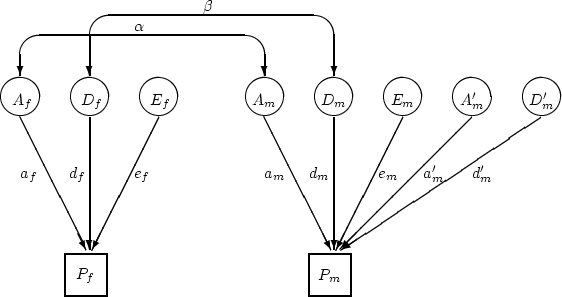The general sex-limitation model allows us to (1) estimate the magnitude of genetic and environmental effects on male and female phenotypes and (2) determine whether or not it is the same set of genes or shared environmental experiences that influence a trait in males and females. Although the first task may be achieved with data from like-sex twin pairs only, the second task requires that we have data from opposite-sex pairs (Eaves et al., 1978). Thus, the Mx script we describe will include model specifications for all 5 zygosity groups (MZ-male, MZ-female, DZ-male, DZ-female, DZ-opposite-sex).
To introduce the general sex-limitation model, we consider a path
diagram for opposite-sex pairs, shown in Figure 9.1. Included
among the ultimate variables in the diagram are female and male
additive genetic (![]() and
and ![]() ), dominant genetic (
), dominant genetic (![]() and
and
![]() ), and unique environmental (
), and unique environmental (![]() and
and ![]() ) effects,
which influence the latent phenotype of the female (
) effects,
which influence the latent phenotype of the female (![]() ) or male
(
) or male
(![]() ) twin. The additive and dominant genetic effects are
correlated within twin pairs (
) twin. The additive and dominant genetic effects are
correlated within twin pairs (![]() = 0.50 for additive effects,
and
= 0.50 for additive effects,
and ![]() = 0.25 for dominant effects) as they are for DZ like-sex
pairs in the simple univariate ACE model. This correlational
structure implies that the genetic effects represent common sets
of genes which influence the trait in both males and females; however,
since
= 0.25 for dominant effects) as they are for DZ like-sex
pairs in the simple univariate ACE model. This correlational
structure implies that the genetic effects represent common sets
of genes which influence the trait in both males and females; however,
since ![]() and
and ![]() or
or ![]() and
and ![]() are not constrained
to be equal, the common effects need not have the same magnitude
across the sexes.
are not constrained
to be equal, the common effects need not have the same magnitude
across the sexes.
 and
and  and
and
Alternatively, a similar estimate may be obtained for dominant
genetic effects. However, the information available from twin pairs
reared together precludes the estimation of both sex-specific
parameters,  and
and ![]() and, consequently, both additive and
dominance genetic correlations. Instead, models including
and, consequently, both additive and
dominance genetic correlations. Instead, models including  or
or ![]() may be fit to the data, and their fits compared
using appropriate goodness-of-fit indices, such as Akaike's
Information Criteria (AIC; Akaike, 1987; see Section
may be fit to the data, and their fits compared
using appropriate goodness-of-fit indices, such as Akaike's
Information Criteria (AIC; Akaike, 1987; see Section ![[*]](crossref.png) ).
This
criterion may be used to compare the fit of an
).
This
criterion may be used to compare the fit of an ![]() model to the fit
of an
model to the fit
of an ![]() model. AIC is one
member of a class of indices that reflect both the goodness of fit of
a model and its parsimony, or ability to account for
the observed data with few parameters.
model. AIC is one
member of a class of indices that reflect both the goodness of fit of
a model and its parsimony, or ability to account for
the observed data with few parameters.
To generalize the model specified in Figure 9.1 to other zygosity groups, the parameters associated with the female phenotype are equated to similar effects on the phenotypes of female same-sex MZ and DZ twin pairs. In the same manner, all parameters associated with the male phenotype (reflecting effects which are common to both sexes as well as those specific to males) are equated to effects on both members of male same-sex MZ and DZ pairs. As a result, the model predicts that variances will be equal for all female twins, and all male twins, regardless of zygosity group or twin status (i.e., twin 1 vs. twin 2). The model does not necessarily predict equality of variances across the sexes.